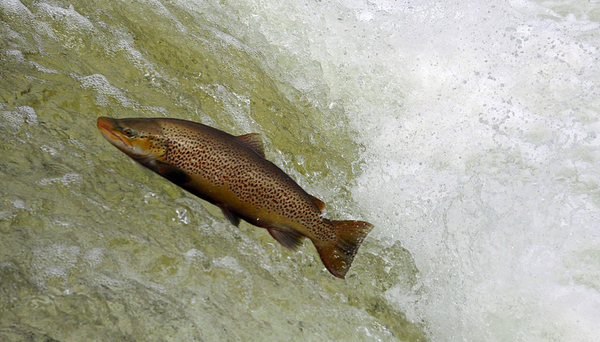Archive detail
The risky life of a lake trout
April 22, 2024 |
All trout begin life in the stream. While river trout spend their entire lives in their natal stream, lake trout migrate after some time to the lake, returning later to spawn. Despite their different lifestyles, river and lake trout belong to the same species – in Switzerland mostly the Atlantic trout (Salmo trutta), by far the most common variety here. The offspring of a lake trout can develop into either lake or river trout. The same is true for the offspring of river trout. The drive to migrate is, however, partially hereditary. The offspring of lake trout thus have a higher probability of migrating to the lake than the offspring of river trout.
Their life strategy as an already highly at-risk aquatic animal makes the lake trout an especially endangered species. As they switch habitats, the associated risks add up: increasing temperatures in their natal stream owing to climate change, migration obstacles such as dams on their path to the lake or fisheries in the lake itself. More information about the various populations in Swiss lakes and their differences is needed in order to protect and support lake trout better. This knowledge is being generated in a nationwide research project in Switzerland by the River Fish Ecology research group of the aquatic research institute Eawag, under the leadership of Jakob Brodersen.
Professional and amateur fishers help with sampling
To be able to investigate all natural Swiss lakes and their tributaries, the researchers in this project needed the help of professional and amateur fishers. These groups supported the researchers with the sampling of the 21 lakes overall, primarily by providing samples of the lake trout. The researchers examined the fish for both genetic and ecological differences, such as how the trout differ in growth. They also tagged trout in Lake Lucerne with microchips to follow their migrations.
But why do lake trout choose such a risky life strategy? The reason is that lakes provide more nutrition. Lake trout thus grow faster, grow bigger and can generate more offspring than their riverine cousins. The more time they spend in the lake, the bigger they become. While a river trout is rarely longer than 50 cm, fully grown lake trout can often measure over 70 cm, sometimes even reaching more than a metre in length. However, their life strategy means they have a higher risk of not surviving to reproduce at all.
“Many lake trout leave their natal stream in spring in their second year of life, when they are 10 to 20 cm long,” explains Dominique Stalder, who is working on her doctorate as part of the Lake Trout Project. However, the timing of the migration varies from stream to stream and from fish to fish. “Large fish tend to migrate earlier than small fish as the risk of dying during migration decreases with size,” says Stalder. All in all, young trout face a lot of risks. The downstream journey to the lake is already dangerous. The lake harbours predators like birds and other fish, as well as nets and bated hooks.
Lake trout from different tributaries differ
Just like salmon, lake trout return to spawn in the same stream where they hatched. “There are big differences in body size among the returning fish,” adds Dominique Stalder. Trout that migrate down to the lake early on and stay there longer grow larger, but then have a lower chance of survival. There are also differences in body size between different lakes and even between different tributaries of the same lake, even though the fish then grow up in the same habitat. While some fish already return to their stream to spawn after their first summer in the lake, most stay in the lake for another year. Some even remain there for up to four years.

When a lake trout reaches its spawning ground, its riskier strategy pays off as – thanks to its larger size – lake trout lay significantly more eggs than their sedentary cousins, sometimes more than 10,000 in one season. Then again, fewer than 10 percent of the fish that migrated make it back to their natal stream to spawn.
The researchers also investigated the trout for genetic differences. They found out that in many lakes, trout populations coming from different tributaries into the same lake have genetic differences. “As lake trout always return to where they hatched, it seems obvious that populations from different streams have adapted to the relevant local conditions within their natal streams,” says project leader Jakob Brodersen. Whether that is actually the case, however, still requires closer examination. Genetic diversity within a species can be important for the ability of the species to adapt, for example to environmental conditions. The expression of a specific physical characteristic (e.g. a shorter or longer jaw) or behaviour (e.g. spawning earlier or later) can then suddenly become an advantage.

Maintaining diversity
“This is relevant, for example, in fish farms, where fish are bred to be released into the waterways to increase fish stocks,” explains Andrin Krähenbühl from the fisheries advisory board FIBER, who is helping to translate the research findings from the lake trout project into practice. Such fish stocking is practised in many bodies of water in Switzerland.
One approach for protecting the lake trout overall could be adaptations to the size guidelines for fish that are caught. “In waters where the lake trout only return to spawn at a high age, their size is already greater than the minimum catch size,” says Andrin Krähenbühl. “This means that trout that have never spawned are allowed to be caught in the lake.” To protect the trout in such lakes better, larger minimum catch sizes or stricter total catch amounts could be considered.
Cover picture: Changing habitats increases risks for lake trout. (Photo: Michel Roggo)
Financing / Cooperations
- Eawag
- BAFU

